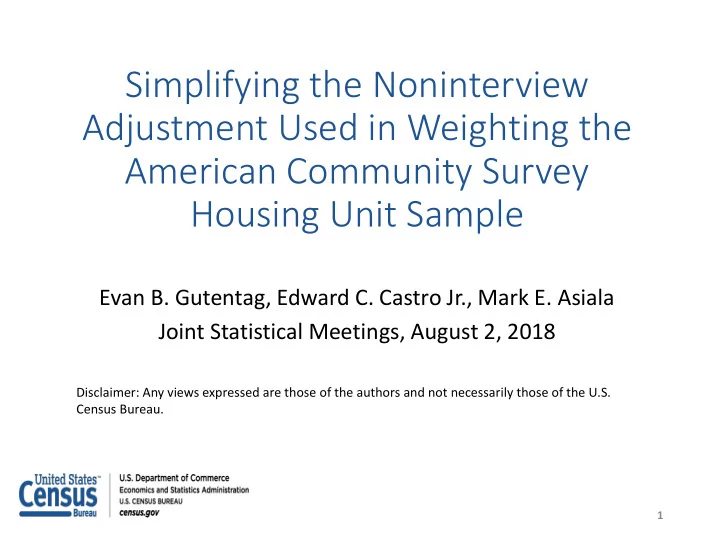

Simplifying the Noninterview Adjustment Used in Weighting the American Community Survey Housing Unit Sample Evan B. Gutentag, Edward C. Castro Jr., Mark E. Asiala Joint Statistical Meetings, August 2, 2018 Disclaimer: Any views expressed are those of the authors and not necessarily those of the U.S. Census Bureau. 1
Presentation Outline • Introduction • Background • Methodology • Results • Conclusions 2
Introduction 3
Motivation • American Community Survey (ACS) has low housing unit nonresponse rate (e.g., 4.2% in 2015, 5.3% in 2016) (U.S. Census Bureau, 2017) • ACS housing unit weighting noninterview (NI) adjustment uses three factors • Low nonresponse rate suggests we could simplify NI adjustment 4
Research Questions • How would simplifying the NI adjustment affect the mean square error (MSE) of estimates? • How much of the MSE of estimates is composed of bias versus variance? 5
Background 6
Essential Information • Data collection: - Month 1: mail and internet - Month 2: telephone - Month 3: in-person (CAPI) • Weighting: - Probability of selection - NI adjustment - Coverage adjustment 7
Current NI Adjustment • Two parts • Part 1 reduces nonresponse bias - First noninterview adjustment factor (NIF1) - Second noninterview adjustment factor (NIF2) • Part 2 reduces “mode bias” from Part 1 - Mode noninterview adjustment factor (NIFM) - Mode bias factor (MBF) • Computed within single counties/groups of counties 8
Part 1 (NIF1 and NIF2) • NIF1: building type x census tract • NIF2: building type x data collection month • Shift weight of NIs to interviews • Two factors are used instead of one to reduce variance • Interviews from all modes are used, which may introduce mode bias 9
Part 2 (NIFM) • NIFM weights: - Independent of NIF1, NIF2 - Only used to compute MBF, reduce mode bias • Building type x data collection month • Shifts weight of NIs to CAPI interviews • NIFM may reduce bias more than current NI adjustment, but it increases variance and MSE (Adeshiyan, 1998) 10
Part 2 (MBF) • Household tenure x data collection month x marital status of householder • Computed using interviews only • Applied to the weights after NIF2 • Within each cell, weighted total same as if NIFM was used, but shifts weight of NIs to all interviews, reducing mode bias without causing large variance increases 11
Methodology 12
Data • 2011-2015 ACS 5-year data • Group quarters data excluded • Tract-level estimates examined • 40 housing unit characteristics (e.g., proportion housing units rented) • 13 person characteristics (e.g., proportion persons unemployed) 13
Weights • Two sets of NI-adjusted weights compared - Current weights (CUR): NIF1 x NIF2 x MBF - Experimental weights (EXP): NIF1 only • No coverage adjustment applied to these weights 14
Analysis Measures • NIFM estimate was benchmark for bias estimation • Measures: - Relative MSE (MSE = Variance + Bias 2 ) - Change in relative MSE: (EXP – CUR)/(CUR) - Relative variance and relative square bias • Measures relative to square estimate to account for estimate size 15
Examining Results • Tract-level distributions of each measure obtained for each characteristic • Mean values at select percentiles shown • Estimates not significantly different from zero at α = 0.1 when formed using current and experimental weights were excluded in order to remove low-quality estimates 16
Results 17
Mean Relative MSE 80 CUR 70 EXP 60 Mean Relative MSE (%) 50 40 30 20 10 0 0th 10th 20th 30th 40th 50th 60th 70th 80th 90th 100th Percentile Source: 2011-2015 American Community Survey (ACS) 5-Year Data Note: For more information on sampling error, non-sampling error, and confidentiality protection in the ACS, see https://www.census.gov/programs-surveys/acs/technical-documentation/code-lists.html. 18
Mean Change in Relative MSE (%) Percentile 0 th 1 st 5 th 25 th 50 th 75 th 95 th 99 th 100 th -22.71 -4.45 -2.22 -0.66 -0.10 0.40 1.77 3.90 33.72 Source: 2011-2015 American Community Survey (ACS) 5-Year Data Note: For more information on sampling error, non-sampling error, and confidentiality protection in the ACS, see https://www.census.gov/programs-surveys/acs/technical-documentation/code-lists.html. 19
Mean Relative Variance and Relative Square Bias 45 Rel. Var. (CUR) 40 Rel. Var. (EXP) 35 Mean Measure Value (%) Rel. Sq. Bias (CUR) 30 Rel. Sq. Bias (EXP) 25 20 15 10 5 0 0th 10th 20th 30th 40th 50th 60th 70th 80th 90th 100th Percentile Source: 2011-2015 American Community Survey (ACS) 5-Year Data Note: For more information on sampling error, non-sampling error, and confidentiality protection in the ACS, see https://www.census.gov/programs-surveys/acs/technical-documentation/code-lists.html. 20
Conclusions • Simplifying NI adjustment did not notably affect estimate quality • NI cells defined by small, local geography and building type sufficiently account for nonresponse bias • Simplified NI adjustment will be used in ACS housing unit weighting starting in data year 2017 21
Acknowledgements We thank Keith A. Albright, Carolina Franco, and Patrick J. Cantwell for comments that improved this presentation. 22
References Adeshiyan, S. (1998). A Study of the Weighting Adjustment Procedures for the American Community Survey. JSM Proceedings, Survey Research Methods Section (pp. 178-183). Alexandria, VA: American Statistical Association. U.S. Census Bureau. (2014). American Community Survey Design and Methodology (January 2014). Retrieved July 25, 2018, from U.S. Census Bureau: https://www2.census.gov/programs- surveys/acs/methodology/design_and_methodology/acs_design_methodology_report_2014.pdf U.S. Census Bureau. (2017). American Community Survey: Response Rates. Retrieved April 10, 2018, from U.S. Census Bureau: https://www.census.gov/acs/www/methodology/sample-size-and-data- quality/response-rates/ Weidman, L., Alexander, C., Diffendal, G., & Love, S. (1995). Estimation Issues for the Continuous Measurement Survey. Retrieved April 11, 2018, from U.S. Census Bureau: https://www.census.gov/content/dam/Census/library/working- papers/1995/acs/1995_Weidman_01.pdf 23
Contact Information • Evan B. Gutentag - evan.benson.gutentag@census.gov • Edward C. Castro Jr. - edward.c.castro@census.gov • Mark E. Asiala - mark.e.asiala@census.gov 24
Recommend
More recommend